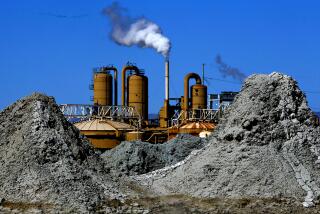Superfund Goal: The Unleading of Silver Valley : Public health: More than a century of heavy-metals pollution weighs on the area’s people. A $100-million cleanup is under way.
KELLOGG, Ida. — Eleanor Gearhart’s three sons were not yet alive in 1973, when a malfunctioning smelter spewed hundreds of pounds of lead into the air over Silver Valley. But their mother worries, just the same.
The boys, ages 6, 9 and 17, have had their blood tested for lead poisoning. “As of right now, they don’t have anything that I know of,” their mother says.
But that does not allay her fears, or those of other parents. Only a massive cleanup of the heavy metals that have contaminated this part of northern Idaho will do that.
It all started with a bag-house fire at the Bunker Hill smelter that knocked out filters in the smelter’s flue and stack system in 1973.
Rather than shutting down and repairing the pollution-control system, Bunker Hill released untreated wastes up the main smokestack for six months, said Ian Von Lindern, a consultant to the state Department of Health and Welfare.
“Honestly, folks, this is a situation that hasn’t occurred anywhere else in the Free World that we know of,” Von Lindern said.
The health hazards were immediate. Children, who are more likely to put rocks and dirt in their mouths, are most at risk for lead poisoning, which can stunt growth and diminish intelligence.
In 1974, a study of 201 children living within a mile of the smelter found unhealthful levels of lead in their blood--an average of 65 micrograms per deciliter. The nationwide standard was 25 micrograms at the time.
In 1977, parents of nine children sued the Bunker Hill Co. for $20 million. The case was settled for an undisclosed amount in 1981.
By 1991, 49 children tested in the 1-mile area had average blood-lead levels of 7 micrograms, the national average, said Jerry Cobb, director of the Panhandle Health District in nearby Silverton.
Still, fear remains. That is why Gearhart sent her sons for blood tests, and that is why she has joined the Moms and Grandmas, a small group of Silver Valley residents who work with the Idaho Citizens’ Network, pressing for medical assistance along with a cleanup.
Everyone in the group has a story to tell about an illness or defect they believe was a consequence of being “leaded.” Many people here have their blood tested every year, and they want the federal government to establish a $40-million trust fund to pay for medical treatment.
“The aftereffects of the smelter are very, very frightening,” said Barbara Miller, an organizer for the Idaho Citizens’ Network.
In 1983, the U.S. Environmental Protection Agency declared a 21-square-mile area around the Bunker Hill facility to be a Superfund cleanup site.
The cleanup, expected to cost more than $100 million, is scheduled for completion within 10 years, said John Meyer, a spokesman for the EPA in Seattle. Cobb said the work seems slow, but it is progressing.
“It’s kind of like watching the ice flow. If you stand there every day and look at it, it doesn’t look like it’s moving, but if you drive a stake in it and go away for a while, you can see it’s moving,” Cobb said.
Much of the work so far has involved removing lead-contaminated soil from parks and playgrounds, and replacing the soil in the yards of more than 400 homes occupied by pregnant women or young children, he said.
The sodding project eventually may be extended to more than 1,000 tainted yards.
Cleanup and reclamation activities also are under way in unoccupied areas that have been contaminated with lead, arsenic, zinc and other heavy metals over a century of mining and smelting.
The goal is to get off the Superfund list and “get on with our lives. We’re getting close to it,” Cobb said. A final plan for the overall Superfund cleanup may be finished by late summer, Meyer said.
Then, owners and operators must be persuaded to sign a consent decree as to who will pay for the cleanup, he said.
“It’s a very complex law. There’s a lot of liability,” he said. “It’s also a very big site.”
Gulf Resources and Chemical Corp. of Houston closed Bunker Hill in 1991. The next year, it sold the complex to the Bunker Limited Partnership, now controlled by three northern Idaho businessmen. The partnership filed for protection from creditors under the U.S. Bankruptcy Code in 1991.
The EPA has named Gulf Resources, the partnership and 13 other companies as potentially responsible for the cleanup. The agency is in regular contact with the companies.
“It’s been a pretty good cooperative effort to get where we are today,” Meyer said. “Nobody’s pulled out yet.”
More to Read
Sign up for Essential California
The most important California stories and recommendations in your inbox every morning.
You may occasionally receive promotional content from the Los Angeles Times.










